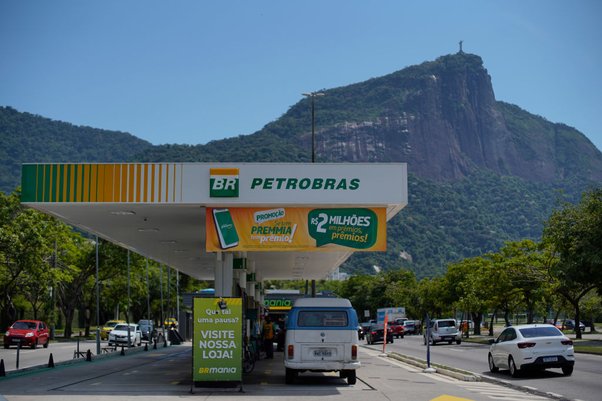
- Petrobras is projected to produce 1/3 more oil in 2030 than in 2024
- Oil production expanding faster than nearly any other major company
- State firm set to spend $230 billion on new oil and gas by 2050
The state oil company of COP30 host Brazil plans to expand oil production more aggressively than nearly every other major producer this decade, according to new analysis from Global Witness
Petrobras is projected to produce almost a third (32%) more oil in 2030 than it did last year, topping a billion barrels in 2030 alone. That’s the year by which humanity’s emissions must fall more than 40% to keep in play the 1.5°C warming target that is supposed to be a lodestar for COP30 climate negotiations, to be held in Brazil later this year.
Among the top 25 producers worldwide, only TotalEnergies plans a more rapid oil production increase (34%) this decade, according to the analysis. This means that – although its absolute volume may be lower – Petrobras is growing production faster than global state-owned fossil fuel giants Saudi Aramco and ADNOC (Abu Dhabi National Oil Company), as well as the largest publicly listed firms ExxonMobil, Chevron, Shell and BP.
Furthermore, Petrobras – which claims it aims to achieve net-zero emissions by 2050 – is planning to produce nearly 4 billion barrels of “new” oil by mid-century. This is oil in fields that are not currently producing or being developed for production. The IEA and the UN both say that no new oil and gas is consistent with the 1.5°C Paris Agreement temperature goal.
In total, the oil and gas Petrobras is set to produce by 2050 will emit an equivalent of 7.9 billion tonnes of CO2 – equivalent to the annual emissions of the US and EU combined, or 16 years worth of Brazil’s total emissions. The company is set to spend $770 billion on oil and gas by 2050, according to the analysis.
An astonishing $230 billion of this is projected to be spent on new oil and gas production. Brazil, home to the Amazon Rainforest and a global biodiversity hotspot, is both a major producer and consumer of fossil fuels. It is the third successive oil and gas exporter to host COP, following the United Arab Emirates (UAE) in 2023 and Azerbaijan 2024.
Global Witness revealed last year that the UAE had used its hosting of COP28 to pursue nearly $100 billion of oil and gas deals. It also exposed COP29 host Azerbaijan fishing for fossil fuel deals, in a further example that industry interests have hijacked global climate diplomacy for its own means.
While there is currently no Petrobras official on the COP30 organising committee, Global Witness is concerned that the state oil company’s production plans – which are at odds with the stated aims of the UN-led climate process– could hinder Brazil’s ability to achieve the ambition and scope of national emissions reduction pledges in line with 1.5°C.
Brazilian president Luiz Ignacio Lula da Silva recently called for oil exploration in the Amazon to be accelerated, accusing the state environmental watchdog IBAMA of “working against the government” in its compliance procedures.
Petrobras has projects in the rainforest that are pending state approval. In March, the Minister for Mines and Energy Alexandre Silveira also urged IBAMA to speed up approval of a Petrobras-operated oil field off the northeastern coast in an area home to “Brazil’s Great Barrier Reef”.
Patrick Galey, Head of Fossil Fuel Investigations at Global Witness, said:
“With the world’s eyes on Brazil ahead of COP30, the hosts of this year's UN climate talks must reckon with their own role in the climate crisis.
"President Lula has talked a good game on green ambition, but Petrobras' state-sanctioned plans to massively ramp up fossil fuel production make a mockery of the Paris agreement/ international commitments to limit warming.
"New oil and gas drilling in Brazil would mean more planet-wrecking pollution, and more destruction of the Amazon – after a year where we've already seen record-breaking heat, unprecedented floods and threats to Indigenous defenders.
"If Brazil wants to be the climate leader the world needs, Lula should keep its oil and gas in ground, and instead scale up a just green energy transition.”
Methodology
- The data oil and gas production for 2024-2025 were sourced from energy business intelligence agency Rystad Energy’s UCube database. UCube is an integrated field-by-field database of the global upstream oil and gas market, covering the time span from 1900 to 2100. Rystad’s data is widely referenced by major oil and gas companies, the media and international bodies such as the IEA.
- UCube takes into account oil and gas demand to project asset-level supply. Projections are based on data sources including company reporting (e.g., earnings and profits reporting) and policies, government sources, energy service reporting, energy agencies, and academic research and news articles. Where reported data is unavailable, data is modelled based on the above sources and supported by a comprehensive database of global oil and gas fields.
- UCube separates hydrocarbon volume by lifecycle category; abandoned (fields that have been abandoned or where owners have paused production); seasonal (production based on e.g. agriculture, such as biodiesel and bioethanol); producing (assets that are currently producing including refinery gains); under development (fields where development has been approved by companies and government but where production is yet to start); discovery (assets where hydrocarbons have been discovered but are not currently being developed); undiscovered (assets where discoveries are yet to be made) and unknown. To calculate what constitutes “new oil and gas” we include volumes and expenditure only relating to the discovery and undiscovered lifecycles, which we have combined for each company.
- Economic values as expenditure are the combined annualised capex, exploratory capex and opex investment in all a given company’s oil and gas operations, which we combined.
- We based our emissions calculations on values taken from the European Investment Bank’s 2023 Carbon Footprint Methodologies to arrive at overall end use (Scope 3) emissions volumes from ADNOC’s operated oil and gas production.
- Emissions comparisons are taken from the European Commission’s EDGAR (Emissions Database for Global Academic Research).


